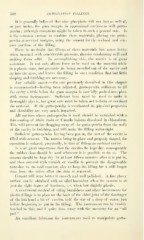Page 362 - My FlipBook
P. 362
3G0 COMBINATION FILLINGS.
It is generally believed that /ine ph<)S|)hate will not last as well at,
or just under, the gum margin in a])j)roxinuil cavities as will gutta-
percha ; although exceptions might be taken to such a general rule. It
is the common custom to combine these materials, placing the gutta-
percha at cervical margins, using the cement for the oc(;lusal and con-
tour portions of the filling.
There is no doubt that fillings of these materials last much better
when inserted with considerable pressure, thereby condensing well and
making them solid. In accomplishing this, the matrix is of great
assistance. It not only allows force to be used on the material while
in a plastic state, but prevents its being crowded out of the cavity and
up into the gum, and leaves the filling in such condition that but little
shaping and finishing are necessary.
Any suitable matrix—the one previously described in this chapter
is recommended—having been adjusted, gutta-percha sufficient to fill
the cavity a little below the gum margin is carefully packed into place
with warm instruments. Sufficient heat must be used to make it
thoroughly plastic, but great care must be taken not to burn or overheat
the material. If the gutta-percha is overheated its physical properties
and durability are very much impaired.
All cavities where gutta-percha is used should be varnished with a
thin coating of white resin or Canada balsam dissolved in chloroform.
This will prevent the dragging away of the gutta-percha from the walls
of the cavity in finishing, and will make the filling water-tight.
Sufficient gutta-percha having been put in, the rest of the cavity is
filled with cement. The matrix being in place and properly shaped, the
operation is reduced, practically, to that of filling an occlusal cavity.
It is of great importance that the cavities be ke])t dry, consequently
the rubber dam should be used wherever it is possible to do so. The
cement should be kept dry for at least fifteen minutes after it is put in,
and then covered with varnish or vaselin to prevent the disagreeable
taste due to its acid reaction, also to keep the filling for a still longer
time from the saliva after the dam is removed.
Cement will wear better if smooth and well polished. A fine glossy
surface can be obtained with an oiled burnisher when the cement is at
just the right degree of hardness, i. e. when but slightly })lastic.
A convenient method of oiling burnishers and other instruments for
plastic fillings is to place on the back of the third joint of the forefinger
of the left hand a bit of vaselin, half the size of a drop of water, just
before beginning to put in the filling. The instrument can be readily
touched to this, and it quite does away with the necessity for an " oil
pad."
An excellent lubricant for instruments used to manipulate gutta-


